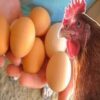The carrot umbel is an interesting botanical feature found in the flowering structure of the carrot plant (Daucus carota), a member of the Apiaceae family. This characteristic flowering part is known as an “umbel,” a term used to describe a type of inflorescence where individual flower stalks, or pedicels, arise from a common point, resembling the ribs of an umbrella. This structure is typical of many members of the Apiaceae family, such as dill, parsley, and Queen Anne’s lace.
The carrot plant typically begins its life as a rosette of finely divided, feathery leaves. In its second year, if it’s a biennial variety, it bolts, sending up a tall flower stalk that can reach heights of up to one meter or more. At the top of this stalk is the umbel. Initially, the umbel is a tight cluster of flower buds, which gradually open to reveal small, white flowers. These flowers are usually five-petaled and form a dense, flat-topped cluster. In the center of the umbel, there may be a single dark red or purple flower, which serves to attract pollinators, a feature especially prominent in wild carrot varieties.
Each flower within the umbel is a complete unit, containing both male (stamens) and female (pistils) reproductive organs. The structure of the umbel is particularly advantageous for attracting a variety of pollinators, including bees, butterflies, and beetles. The flat surface of the umbel provides an easy landing platform for these insects, while the density of flowers ensures a high concentration of nectar and pollen, making it an efficient source of food. The arrangement also increases the chances of cross-pollination, as insects move from one flower to another within the same umbel.
The umbel’s formation is influenced by various environmental factors, including light, temperature, and nutrient availability. The growth of the flower stalk and the subsequent umbel is a sign that the plant is shifting its energy from vegetative growth to reproductive activities. This transition is marked by hormonal changes within the plant, particularly the increase in gibberellins, which promote the elongation of the flower stalk, and cytokinins, which stimulate the development of the floral parts.
After pollination, each flower in the umbel produces a small, dry fruit known as a schizocarp. These fruits eventually split into two one-seeded mericarps upon maturity. The seeds are then dispersed by wind, animals, or human activity, ensuring the propagation of the species. In cultivated carrots, the seeds are harvested and used for planting the next crop cycle.
The structure of the carrot umbel also plays a role in plant defense. The concentration of flowers in a single area can help protect against herbivores, as the sheer number of blossoms can overwhelm potential pests. Additionally, the presence of secondary metabolites in the flowers and surrounding tissues can deter herbivory and reduce the incidence of diseases.
Understanding the carrot umbel’s role in the life cycle of the carrot plant provides insight into the broader ecological interactions of the Apiaceae family. The umbel is not only crucial for reproduction but also represents a finely tuned adaptation to attract pollinators, optimize seed dispersal, and enhance survival in various environments. This structural adaptation underscores the intricate relationships between plant morphology and ecological function, highlighting the evolutionary success of the carrot and its relatives in the Apiaceae family.
The Economic Importance and Uses of Carrot Umbel

1. Pollinator Attraction: Carrot umbels are highly effective at attracting pollinators such as bees, butterflies, and other insects. The flat-topped clusters provide an ideal landing platform and a rich source of nectar and pollen, which are essential for the health and sustainability of pollinator populations. This attraction is crucial for the pollination of various crops, enhancing agricultural productivity.
2. Seed Production: The primary function of the carrot umbel is to produce seeds. These seeds are vital for the propagation of carrot crops. Farmers rely on the seeds harvested from umbels to plant new crops, ensuring a continuous and reliable supply of carrots for the market.
3. Essential Oils: Carrot seeds, harvested from the umbels, are processed to extract essential oils. These oils are valued in aromatherapy for their soothing and therapeutic properties. They are also used in cosmetics for their skin-rejuvenating benefits.
4. Culinary Uses: Carrot seeds are used as a spice in various culinary traditions, particularly in Indian and Middle Eastern cuisines. The seeds add a unique flavor to dishes and are an essential ingredient in spice blends like garam masala.
5. Medicinal Uses: In traditional medicine, carrot seeds are used to treat digestive issues, reduce inflammation, and act as diuretics. The seeds contain bioactive compounds that contribute to their therapeutic effects.
6. Cosmetic Industry: The essential oils derived from carrot seeds are used in the cosmetic industry to formulate skincare products. These products leverage the anti-aging and moisturizing properties of the oils, making them popular in anti-wrinkle creams and lotions.
7. Agricultural Pollination: Carrot umbels are strategically used in agricultural systems to improve pollination efficiency. By attracting a diverse range of pollinators, umbels help ensure the successful fertilization of nearby crops, enhancing overall yield.
8. Biodiversity Conservation: Growing carrot plants with their umbels contributes to biodiversity conservation by providing habitats and food sources for various pollinator species. This, in turn, supports ecosystem health and stability.
9. Livestock Feed: The residual plant material, including umbels, can be used as livestock feed. This practice provides an economical and nutritious feed source for animals, promoting sustainable farming practices.
10. Organic Farming: Carrot umbels play a role in organic farming by enhancing soil health and reducing the need for chemical fertilizers and pesticides. Their presence in crop rotations can improve soil structure and fertility.
11. Herbal Teas: Infusions made from carrot seeds are used in herbal teas. These teas are known for their detoxifying properties and are consumed to promote digestive health.
12. Perfume Industry: The aromatic compounds extracted from carrot seeds are used in the creation of perfumes. These natural fragrances are highly valued for their unique scent profiles.
13. Pharmaceutical Applications: Carrot umbel extracts are studied for their potential health benefits, including antioxidant, anti-inflammatory, and antimicrobial properties. These extracts are incorporated into pharmaceutical products for various therapeutic applications.
14. Soil Improvement: After the carrot plants have completed their life cycle, the decomposed umbels can be used as organic matter to enrich the soil. This practice improves soil fertility and structure, promoting healthy plant growth.
15. Pest Control: The strong scent of carrot umbels can act as a natural pest repellent. By planting carrot umbels alongside other crops, farmers can reduce the incidence of pest infestations without relying on chemical pesticides.
16. Companion Planting: Carrot umbels are used in companion planting strategies to protect crops. They attract beneficial insects that prey on pests, thereby enhancing the health and productivity of the main crop.
17. Dyes and Pigments: Natural dyes can be derived from carrot umbels and used in textiles and art. These dyes provide an eco-friendly alternative to synthetic colorants.
18. Educational Value: Carrot umbels are valuable in botanical education and research. They are used to teach students about plant reproduction, pollination mechanisms, and the ecological importance of flowering plants.
Read Also Processing of Pig Products and Record Keeping
The Products and By-products That Can Be Derived From Carrot Umbel

1. Carrot Seed Oil: Carrot seed oil is extracted through steam distillation of the seeds found in the umbels. This oil is used in cosmetics for its skin-nourishing properties and in aromatherapy for its calming effects.
2. Essential Oils: Essential oils derived from carrot seeds are used in perfumes and skincare products. The extraction process involves steam distillation, which captures the volatile aromatic compounds.
3. Carrot Seed Spice: Dried and ground carrot seeds are used as a spice in various culinary applications. The seeds are harvested from the umbels, dried, and then milled into a fine powder.
4. Herbal Teas: Carrot seeds are used to brew herbal teas. The seeds are steeped in hot water to release their beneficial compounds, resulting in a tea known for its detoxifying and digestive benefits.
5. Carrot Seed Extract: Carrot seed extract is obtained by solvent extraction or cold pressing. This extract is used in pharmaceuticals for its potential health benefits, including anti-inflammatory and antioxidant properties.
6. Livestock Feed: After the harvest, the residual umbels can be processed into livestock feed. This feed provides a cost-effective and nutritious source of food for animals, contributing to sustainable farming practices.
7. Organic Fertilizer: Decomposed carrot umbels are used as organic fertilizer. The umbels are composted and added to the soil to improve its fertility and structure, enhancing plant growth.
8. Natural Pesticide: Extracts from carrot umbels are used as natural pesticides. The bioactive compounds in the extracts repel pests and reduce the need for chemical pesticides, promoting eco-friendly farming.
9. Companion Planting: Carrot umbels are used in companion planting to protect crops. By planting umbels alongside other crops, farmers can attract beneficial insects that control pest populations.
10. Soil Conditioner: Organic matter from decomposed carrot umbels is used as a soil conditioner. This practice enriches the soil with nutrients and improves its water-holding capacity.
11. Botanical Research: Carrot umbels are used in scientific studies to understand plant reproduction and pollination. They serve as a model system for studying the ecological interactions between plants and pollinators.
12. Educational Material: Carrot umbels are used in educational programs to teach students about botany and agriculture. They provide a hands-on learning experience about plant growth and development.
13. Dyes: Natural dyes derived from carrot umbels are used in textiles. The umbels are processed to extract pigments, which are then used to dye fabrics in an eco-friendly manner.
14. Perfume Ingredient: The aromatic compounds from carrot seeds are used in the perfume industry. These natural scents are extracted through distillation and incorporated into high-quality fragrances.
15. Skincare Products: Oils and extracts from carrot seeds are used in skincare products for their moisturizing and anti-aging properties. These ingredients are incorporated into creams, lotions, and serums.
16. Culinary Additive: Carrot seeds are used as a flavor enhancer in various culinary dishes. They add a unique taste to spice blends, sauces, and marinades.
17. Natural Medicine: Traditional remedies use carrot seed extracts for their health benefits. These extracts are believed to aid digestion, reduce inflammation, and act as natural diuretics.
Read Also Poultry Records Keeping Books, Types and Benefits
Frequently Asked Questions (FAQ’s) About Carrot Umbel

1. What is a carrot umbel?
A carrot umbel is the flowering structure of the carrot plant, where individual flowers cluster together from a common point, resembling an umbrella.
2. How are carrot umbels used in agriculture?
Carrot umbels attract pollinators and can be used in companion planting to improve crop health and yield by attracting beneficial insects.
3. Can carrot umbels be eaten?
The umbels themselves are not typically eaten, but the seeds can be used as a spice in various culinary dishes.
4. What products are made from carrot umbels?
Products made from carrot umbels include essential oils, herbal teas, perfumes, natural pesticides, and skincare products.
5. How do carrot umbels benefit pollinators?
Carrot umbels provide nectar and pollen, supporting the diet and activity of pollinators like bees and butterflies, which are essential for crop fertilization.
6. Are carrot umbels used in medicine?
Yes, carrot seed extracts from the umbels are used for their medicinal properties, including digestive aids, anti-inflammatory agents, and diuretics.
7. What is the role of carrot umbels in organic farming?
Carrot umbels enhance soil health, attract beneficial insects, and reduce the need for chemical inputs, supporting sustainable farming practices.
8. How are essential oils extracted from carrot umbels?
Essential oils are extracted through steam distillation, where steam is used to separate the oils from the seeds, capturing the volatile aromatic compounds.
9. Can carrot umbels be used in cosmetics?
Yes, oils and extracts from carrot seeds are used in skincare products for their moisturizing and anti-aging properties, making them popular in lotions and creams.
Read Also Best Organic Fertilizer for Vegetables






